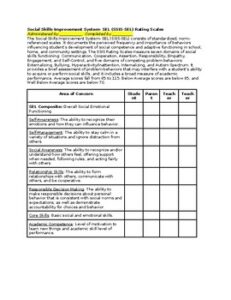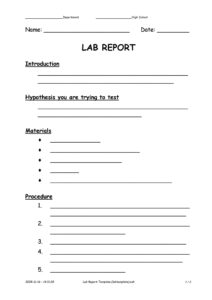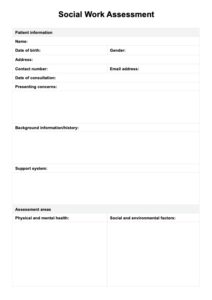Navigating the complexities of cognitive and academic assessments can be a challenging endeavor for any professional. When multiple standardized tests are employed to gain a holistic view of an individual’s abilities, the process is often referred to as a cross-battery assessment. This comprehensive approach allows assessors to draw on various theoretical models and test instruments, providing a much richer, more nuanced understanding of a person’s strengths and areas needing support. It moves beyond the limitations of a single test battery, integrating data to paint a complete picture.
However, gathering this wealth of information is only half the battle. Presenting these intricate findings in a clear, concise, and professionally coherent manner is equally critical. This is where a well-designed report template becomes an invaluable tool. It ensures that all pertinent data is included, that the interpretation is consistent, and that the recommendations are actionable, making the report accessible and useful for parents, educators, and other stakeholders involved in supporting the individual.
Without a structured framework, professionals might find themselves spending excessive time organizing information, potentially omitting crucial details, or struggling to maintain a consistent style across different reports. A robust cross battery assessment report template streamlines this process, allowing practitioners to focus more on the interpretation and less on the administrative task of report generation, ultimately enhancing the quality and efficiency of their work.
Understanding the Core Components of a Cross Battery Assessment Report
A cross-battery assessment involves the careful selection and administration of tests from different standardized batteries to address specific referral questions, often guided by theoretical frameworks like Cattell-Horn-Carroll (CHC) theory. This integration allows for a more comprehensive evaluation of cognitive abilities, academic achievement, and other relevant domains than what a single test typically offers. The richness of this data demands an equally robust reporting structure to ensure clarity and utility.
Given the intricate nature of these assessments, a systematic approach to reporting is not just beneficial, but essential. It helps in organizing disparate pieces of information into a cohesive narrative, highlighting key findings, and translating complex psychometric data into understandable language. A well-structured report prevents information overload and ensures that the most critical insights are easily identifiable by the reader.
When developing or utilizing a cross battery assessment report template, it’s vital to include several key sections that guide the reader through the assessment process and its outcomes. These sections ensure that all necessary information is presented logically and comprehensively, from the initial reasons for evaluation to the final recommendations.
Key Sections to Include
- Identifying Information: Basic demographic details of the individual being assessed.
- Reason for Referral: A clear statement outlining why the assessment was requested.
- Background Information: Relevant developmental, medical, educational, and social history.
- Assessment Procedures: A list of all tests administered and the dates of administration.
- Behavioral Observations: Notes on the individual’s behavior during testing.
- Test Results: Presentation of scores, including standard scores, percentile ranks, and confidence intervals.
- Summary of Findings: A synthesis of the test results, integrating information across batteries.
- Diagnostic Impressions (if applicable): Formal diagnostic statements based on the findings.
- Recommendations: Practical, individualized suggestions based on the assessment results.
Let’s delve a bit deeper into some of these critical areas. The “Background Information” section, for instance, provides crucial context, helping to frame the assessment results within the individual’s life experiences and history. Without this context, test scores can appear in a vacuum, making interpretation less meaningful. A thorough background section can highlight early developmental milestones, previous interventions, or significant life events that might impact current functioning.
The “Test Results” section is where the raw data transforms into interpretable scores. It’s important to present these systematically, often in tables, making it easy for readers to compare scores across different domains and tests. Explaining what standard scores and percentile ranks mean in straightforward language is also crucial, ensuring that the technical aspects of the report are accessible to non-specialists. This section also sets the stage for the interpretive heart of the report, the “Summary of Findings.”
The “Summary of Findings” is arguably the most vital part of any cross battery assessment report template. Here, the assessor synthesizes the findings from various tests, identifying patterns, strengths, and areas of concern. This is where the integration of data from multiple batteries truly shines, allowing for a cohesive narrative that explains how different cognitive processes interact and impact overall functioning. It bridges the gap between raw data and meaningful interpretation.
Finally, the “Recommendations” section translates the assessment findings into actionable steps. These should be specific, realistic, and tailored to the individual’s unique profile. Whether it’s suggesting academic accommodations, therapeutic interventions, or strategies for home and school, the recommendations provide a roadmap for support and future growth, directly addressing the reason for referral.
Crafting Effective and Professional Cross Battery Assessment Reports
Beyond merely including the necessary sections, the way a cross battery assessment report is written significantly impacts its effectiveness. A conversational yet professional writing style ensures that the complex information contained within is understandable to a broad audience, including parents, teachers, and other professionals who may not have extensive psychometric training. Avoiding excessive jargon or, when necessary, clearly defining technical terms, is paramount for ensuring the report is truly useful. The goal is to inform, not to confuse.
The art of data interpretation is central to crafting a compelling report. It’s not enough to simply list scores; the report must explain what those scores mean in relation to the individual’s overall functioning and the initial referral questions. Linking specific test results back to observed behaviors, academic performance, or social-emotional challenges creates a coherent and convincing narrative. This interpretive bridge connects the numbers to the real-world experiences of the individual.
Ensuring accuracy and consistency throughout the report is a hallmark of professionalism. Every detail, from demographic information to score reporting, must be meticulously checked. A well-organized report, consistently formatted and free of errors, instills confidence in its findings and recommendations.
Here are some tips for maintaining high standards in your reporting:
- Proofread thoroughly: Even minor typos can detract from the report’s credibility.
- Use consistent terminology: Stick to the same terms when referring to abilities, tests, and individuals.
- Focus on the individual’s unique profile: Tailor interpretations and recommendations to the specific person, avoiding generic statements.
- Ensure recommendations are evidence-based: Ground all suggestions in assessment findings and best practices.
- Maintain ethical considerations: Always prioritize the individual’s privacy and well-being.
Utilizing a comprehensive and thoughtfully designed template can transform the arduous task of report writing into a more streamlined and impactful process. It provides a solid foundation, ensuring all critical aspects of a thorough evaluation are systematically addressed, from initial data collection to the formulation of actionable strategies. This structured approach helps practitioners consistently deliver high-quality, insightful evaluations that truly serve the needs of the individuals they assess. By clarifying findings and offering practical solutions, these reports become powerful tools for advocacy and intervention, empowering individuals to reach their full potential.




